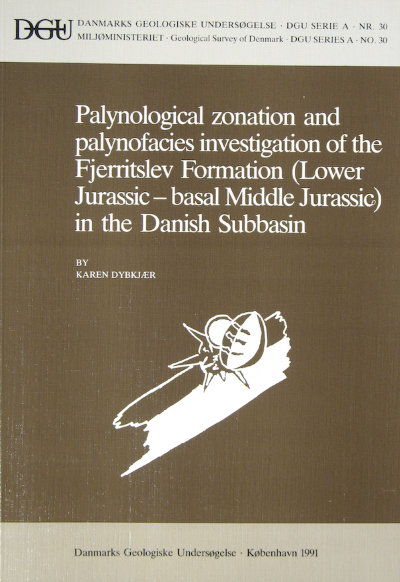Palynological zonation and palynofacies investigation of the Fjerritslev Formation (Lower Jurassic - basal Middle Jurassic) in the Danish Subbasin
DOI:
https://doi.org/10.34194/seriea.v30.7050Keywords:
Biostratigraphy, palynology, palynofacies, Lower Jurassic, the Fjerritslev Formation, the Danish Subbasin, DenmarkAbstract
A detailed study of the palynology and palynofacies of the Fjerritslev Formation (Lower Jurassic - basal Middle Jurassic) has resulted in the definition of four spore/pollen zones and four dinoflagellate cyst zones. The spore/pollen zones are the Corollina - Ricciisporites Zone (Late Rhaetian), the Cerebropollenites macroverrucosus Zone (Sinemurian - Pliensbachian), the Spheripollenites - Leptolepidites Zone (Toarcian), and the Perinopollenites elatoides Zone (Middle Jurassic). The dinoflagellate cyst zones are the Rhaetogonyaulax rhaetica Zone (Rhaetian), the Dapcodinium priscum Zone (latest Rhaetian - earliest Sinemurian), the Liasidium variabile Zone (Sinemurian), and the Nannoceratopsis gracilis Zone (Late Pliensbachian - ?Bajocian/Bathonian). These zones, and the Pinuspollenites - Trachysporites Zone Lund 1977 (Hettangian), are proposed for use in the Danish Subbasin. The combined spore/pollen and dinoflagellate cyst zonation has resulted in a detailed biostratigraphical subdivision of the sequences studied. A new combination, Manumia delcourtii (Pocock 1970) nov. comb. et emend., is proposed here, and the species description emended. New photographs of the holotypes of some of the species erected by Nilsson (1958) are included in the plates. The kerogen assemblages recorded from the Fjerritslev Formation, indicate a marine depositional environment, with a high but variable influence of terrestrially-derived organic particles. Stratigraphic variation in the kerogen assemblages generally correlate with the lithostratigraphical subdivision, and support previous environmental interpretations of the Fjerritslev Formation. Indications of strongly reducing conditions in the bottom waters were found in the Stenlille-2 borehole, in samples here referred to the Early Toarcian. The variations in the kerogen assemblages in the sequence investigated from the Gassum-1 borehole are not correlatable with the other boreholes, but seem primarily to reflect a distinct decrease in bioturbation in the Late Sinemurian. The Fjerritslev Formation does not generally represent a potential source rock for oil. Some levels (parts of the F-111 member) show, however, the characteristics of a fair to good source rock. The organic matter is generally immature or only at the earliest stage of maturity.
Downloads
Published
Issue
Section
License
This article is distributed under a CC-BY 4.0 licence, permitting free redistribution and reproduction for any purpose, even commercial, provided proper citation of the original work. Author(s) retain copyright over the article contents.


